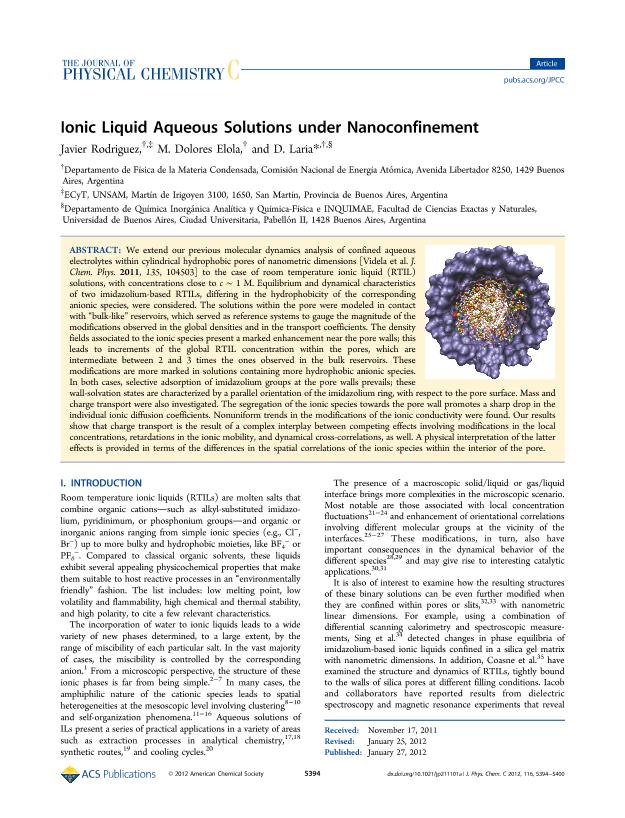Mostrar el registro sencillo del ítem
dc.contributor.author
Rodriguez, Javier

dc.contributor.author
Elola, Maria Dolores

dc.contributor.author
Laria, Daniel Hector

dc.date.available
2019-01-09T20:12:18Z
dc.date.issued
2012-03
dc.identifier.citation
Rodriguez, Javier; Elola, Maria Dolores; Laria, Daniel Hector; Ionic liquid aqueous solutions under nanoconfinement; American Chemical Society; Journal of Physical Chemistry C; 116; 9; 3-2012; 5394-5400
dc.identifier.issn
1932-7447
dc.identifier.uri
http://hdl.handle.net/11336/67850
dc.description.abstract
We extend our previous molecular dynamics analysis of confined aqueous electrolytes within cylindrical hydrophobic pores of nanometric dimensions [Videla et al. J. Chem. Phys.2011, 135, 104503] to the case of room temperature ionic liquid (RTIL) solutions, with concentrations close to c ∼ 1 M. Equilibrium and dynamical characteristics of two imidazolium-based RTILs, differing in the hydrophobicity of the corresponding anionic species, were considered. The solutions within the pore were modeled in contact with "bulk-like" reservoirs, which served as reference systems to gauge the magnitude of the modifications observed in the global densities and in the transport coefficients. The density fields associated to the ionic species present a marked enhancement near the pore walls; this leads to increments of the global RTIL concentration within the pores, which are intermediate between 2 and 3 times the ones observed in the bulk reservoirs. These modifications are more marked in solutions containing more hydrophobic anionic species. In both cases, selective adsorption of imidazolium groups at the pore walls prevails; these wall-solvation states are characterized by a parallel orientation of the imidazolium ring, with respect to the pore surface. Mass and charge transport were also investigated. The segregation of the ionic species towards the pore wall promotes a sharp drop in the individual ionic diffusion coefficients. Nonuniform trends in the modifications of the ionic conductivity were found. Our results show that charge transport is the result of a complex interplay between competing effects involving modifications in the local concentrations, retardations in the ionic mobility, and dynamical cross-correlations, as well. A physical interpretation of the latter effects is provided in terms of the differences in the spatial correlations of the ionic species within the interior of the pore. © 2012 American Chemical Society.
dc.format
application/pdf
dc.language.iso
eng
dc.publisher
American Chemical Society

dc.rights
info:eu-repo/semantics/openAccess
dc.rights.uri
https://creativecommons.org/licenses/by-nc-sa/2.5/ar/
dc.subject
Ionic Liquids
dc.subject
Confinement
dc.subject
Molecular Dynamics
dc.subject
Diffusion
dc.subject.classification
Otras Ciencias Químicas

dc.subject.classification
Ciencias Químicas

dc.subject.classification
CIENCIAS NATURALES Y EXACTAS

dc.title
Ionic liquid aqueous solutions under nanoconfinement
dc.type
info:eu-repo/semantics/article
dc.type
info:ar-repo/semantics/artículo
dc.type
info:eu-repo/semantics/publishedVersion
dc.date.updated
2019-01-02T19:32:24Z
dc.journal.volume
116
dc.journal.number
9
dc.journal.pagination
5394-5400
dc.journal.pais
Estados Unidos

dc.journal.ciudad
Washington
dc.description.fil
Fil: Rodriguez, Javier. Consejo Nacional de Investigaciones Científicas y Técnicas; Argentina. Comisión Nacional de Energía Atómica; Argentina. Universidad Nacional de San Martín. Escuela de Ciencia y Tecnología; Argentina
dc.description.fil
Fil: Elola, Maria Dolores. Consejo Nacional de Investigaciones Científicas y Técnicas; Argentina. Comisión Nacional de Energía Atómica; Argentina
dc.description.fil
Fil: Laria, Daniel Hector. Consejo Nacional de Investigaciones Científicas y Técnicas. Oficina de Coordinación Administrativa Ciudad Universitaria. Instituto de Química, Física de los Materiales, Medioambiente y Energía. Universidad de Buenos Aires. Facultad de Ciencias Exactas y Naturales. Instituto de Química, Física de los Materiales, Medioambiente y Energía; Argentina. Comisión Nacional de Energía Atómica; Argentina. Universidad de Buenos Aires. Facultad de Ciencias Exactas y Naturales. Departamento de Química Inorgánica, Analítica y Química Física; Argentina
dc.journal.title
Journal of Physical Chemistry C

dc.relation.alternativeid
info:eu-repo/semantics/altIdentifier/doi/https://dx.doi.org/10.1021/jp211101a
dc.relation.alternativeid
info:eu-repo/semantics/altIdentifier/url/https://pubs.acs.org/doi/10.1021/jp211101a
Archivos asociados
